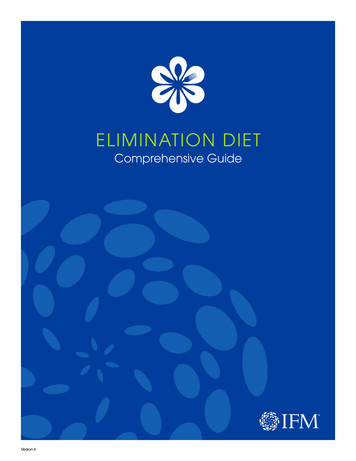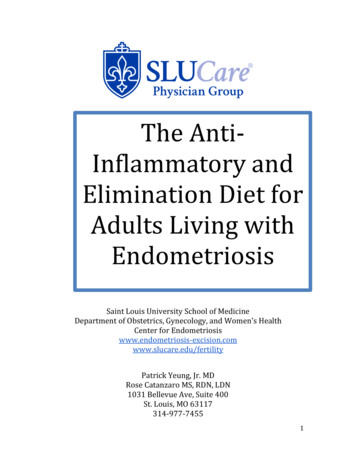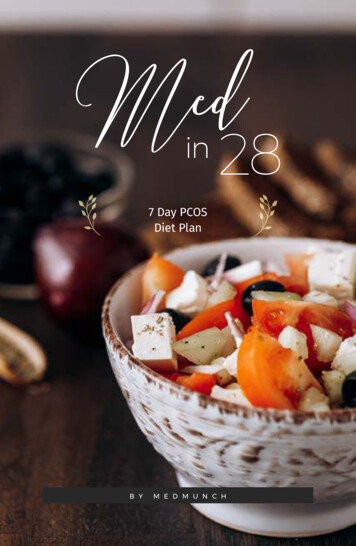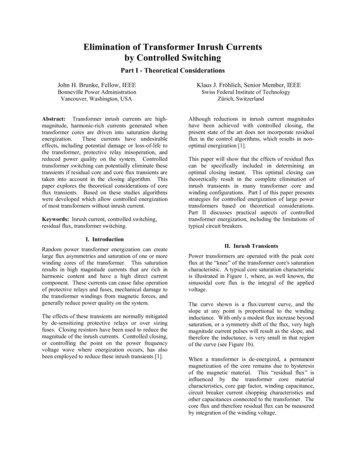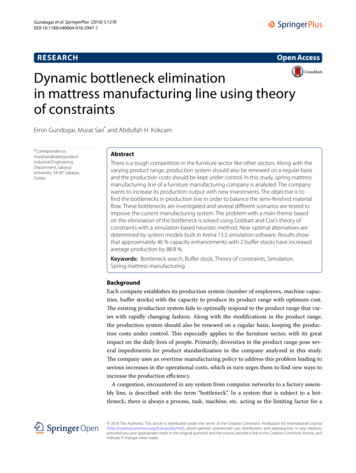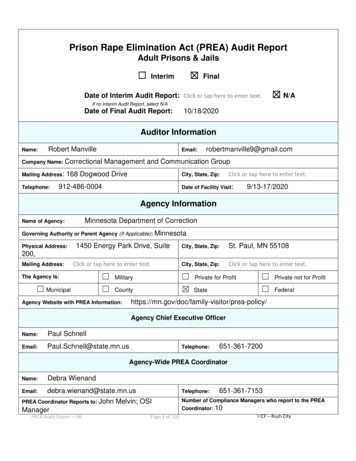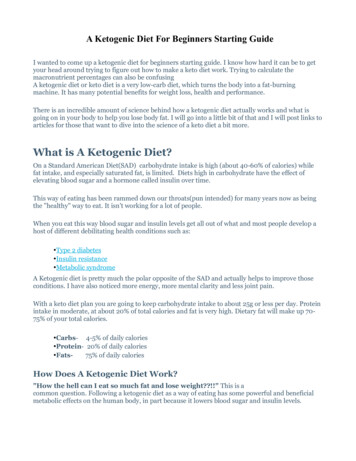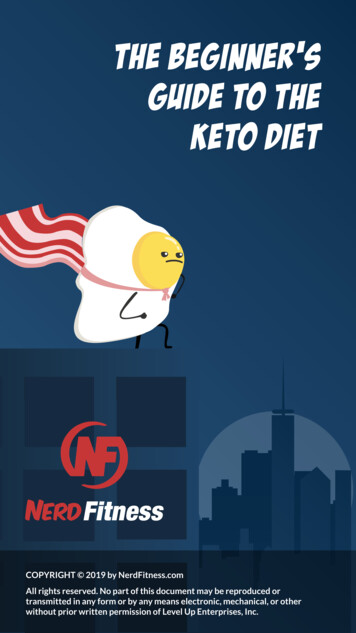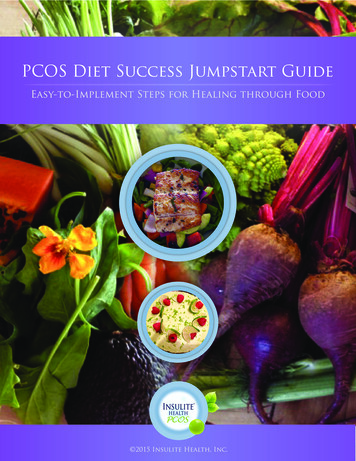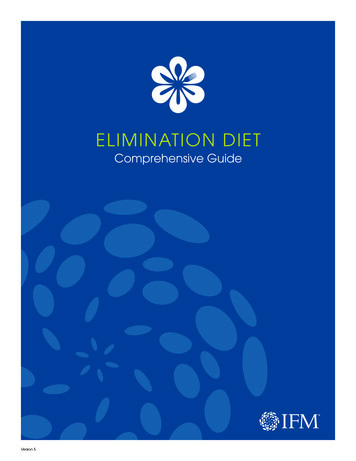
Transcription
ELIMINATION DIETComprehensive GuideVersion 5
Table of ContentsWhy the Elimination Diet?. 3Features of the Elimination Diet. 4Touring Through the Food Plan. 5Getting Started. 11Helpful Hints. 12The Role of Anti-inflammatory Foodsin the Elimination Diet. 13Guidelines for ReintroducingFoods. 16Frequently Asked Questions. 19Resources and Tools for Success. 22 2015 The Institute for Functional Medicine
Why the Elimination Diet?Do you suffer from any of the following conditions: digestive problems, headaches, chronic sinus drainage,low energy, depression, mood swings, eczema, skin irritations, joint aches, asthma, and/or weight gain?Health problems such as these may be related to a specific food or foods eaten frequently. Many people with foodsensitivities don’t even realize how awful they feel until the trigger foods are removed from the diet.Food reactions are a frequently overlooked cause of chronic health issues. Some reactions occur immediately aftereating the food (allergy), but in other cases, symptoms may be delayed by several hours or even days (referred to asfood sensitivity or food intolerance). Removing specific foods from your diet will allow the body to recover andbegin to function efficiently again.These adverse food reactions are common because the same foods are eaten day after day, resulting in greatersensitization to these foods. If the right foods are not eaten, digestion and absorption may be impaired. Additionally,those with weakened immune systems may be more prone to food sensitivities.The Elimination Diet helps to uncover food(s) that may be the culprits. It is a very useful tool for diagnosingadverse food reactions, whether true allergy, intolerance, or sensitivity.Often, symptoms that have failed to respond to conventional medical therapy will resolve by following anElimination Diet. After the initial period of eliminating foods, many chronic symptoms should improve or disappear.When the burden on the immune system is decreased, the body has an opportunity to heal. Along the way, it isimportant to learn how to eat an enjoyable and nutrient-dense diet while starting on the road to optimum health!IFMnElimination Diet Comprehensive Guide 2015 The Institute for Functional Medicine3
Features of the Elimination DietN DIET FEOITATNAURIMESILEINFO RM ATIONnElimination Diet Comprehensive GuidePhto y to nutHea l r ie ntsth eGutCOE N E R GYso t e e ssP r o m re nwaBo dy A o dsoof FNNECTIONMEDICINENoRe Ca lo r ies tr ic ti onIFMRepaIntes irstiPerme nalabilityizednalrsooachPe AppretDiIdenFood tifiesTriggerscesudRe mationamflInescuenReddrBucixTo 2015 The Institute for Functional Medicine4
Touring Through the Food PlanThe two-page Elimination Diet Food Plan is designed to provide a snapshot of the foods that would be availableto choose from every day. A general description of food categories will be helpful before beginning the process ofavoiding foods that may be causing problems.Foods to RemoveFoods to Eatn Cornn Fruitsn Dairyn Healthy oilsn Eggsn Lean meatsn Gluten grains (barley, rye, spelt, wheat)n Legumesn White (table) sugarn Nutsn Shellfishn Seedsn Soyn Vegetablesn Beefn Non-gluten whole grainsn Porkn Processed meatsn Coffee, tea, and chocolateIFMnElimination Diet Comprehensive Guide 2015 The Institute for Functional Medicine5
Touring Through the Food PlanFats & OilsChoose minimally refined, cold-pressed, organic, non-GMO fats and liquid oils whenever possible, as these will bethe best quality. Remember that fats and liquid oils break down in heat, light, and oxygen so keep them in dark glasscontainers and throw them out if they smell rancid. Note that canned coconut milk is included in this category becauseit is predominantly a fat (not a dairy alternative) when purchased in the can.Nuts & SeedsThe nuts and seeds category gives a variety of options to choose from if a snack is needed throughout the day. Theymay be sprinkled on top of salads, cereals, or vegetables. One to two servings of nuts daily are recommended unless oneis allergic.ProteinProtein helps stabilize your blood sugar, which in turn keeps hunger at bay. When possible, include some protein inevery meal. High-quality proteins of any kind are the best choice, including lean, grass-fed, organic, non-GMO sources.LegumesLegumes are a perfect source of quality protein and complex carbohydrate, which gives a sense of fullness and stabilizesblood sugar. At least one serving of legumes on a daily basis in the form of soup, cooked beans, dips, or hummus, isrecommended.Non-Starchy and Starchy VegetablesIdeally, it would be best to get 10-12 servings of vegetables per day. A serving is ½ cup cooked vegetable or 1 cup rawleafy greens. Green vegetables, especially members of the cabbage family, are particularly nutritious for those on theElimination Diet. Eat a “rainbow of colors” in addition to greens: red beets, red peppers, radishes; orange carrots, orangepepper, yams, sweet potatoes, and winter squash; yellow summer squash, yellow peppers; white onions and garlic.IFMnElimination Diet Comprehensive Guide 2015 The Institute for Functional Medicine6
Touring Through the Food PlanThere are compounds in certain vegetables (and fruits) that may cause reactions in sensitiveindividuals. These compounds are called histamines, oxalates, and salicylates. Additionally,healthcare practitioners may choose to have their patients avoid a class of plant foods callednightshades if there is reason to think that these foods are causing symptoms.HistaminesHistamine is a key mediator in inflammation. It occurs naturally in many foods and is also produced by thebody during times of stress and allergy. Histamine is made and stored in mast cells and is released during allergenexposure, causing dilation of blood vessels, increased mucus production, and broncho-constriction. The release ofhistamine results in various symptoms such as itching, sneezing, asthma, headache, and rash. Additionally, certainfoods and food additives prompt the release of histamine from mast cells.nFoods to avoid on a low-histamine diet: bananas, chocolate, strawberries, tomatoes, eggwhites, pork, sauerkraut, cheeses, fermented soy products, sausage, spinach, ketchup, eggplant,alcoholic beverages, smoked meats, vinegars, and canned fish, along with certain foodadditives and preservatives such as tartrazine and other food colors, benzoates, BHA, andBHT.nThe histamine content in foods varies markedly according to storage and maturation;protein foods that may normally be low in histamine will actually have increasing amountsof histamine as they age (e.g., leftover beef) or ripen (a green tomato vs. a ripe tomato).Leftover foods, especially those containing protein, should be frozen immediately. It isgenerally advisable to eat only food that has recently been prepared.OxalatesOxalates are found throughout nature in plants, animals, and humans. Please note that the leaves of a plant typicallycontain higher oxalate levels than the roots, stems, and stalks.High oxalate-containing foods: blackberries, blueberries, raspberries, strawberries, currants, kiwifruit, concord(purple) grapes, figs, tangerines, plums, spinach, Swiss chard, beet greens, collards, okra, parsley, leeks, quinoa, celery,green beans, rutabagas, summer squash, almonds, cashews, peanuts, soybeans, tofu, soy products, wheat bran, wheatgerm, cocoa, chocolate, and black tea.SalicylatesSalicylates are chemicals that occur naturally in many plants. The bark, leaves, roots, and seeds of certain plantsstore salicylates, preventing them from rotting and protecting them against harmful insects, bacteria, and fungi.Many common foods, such as citrus fruits, berries, certain vegetables, herbs, spices, tea, and flavor additives containsalicylates. Chemically related to aspirin, salicylates may also be created synthetically and can be found in manydrugs other than aspirin: analgesics, muscle relaxants, cough mixtures, antacids, cold and flu medication, and acnelotions. Certain perfumes, pesticides, and preservatives also contain salicylates.IFMnElimination Diet Comprehensive Guide 2015 The Institute for Functional Medicine7
Touring Through the Food PlanIn addition to specific foods that contain large amounts of salicylates, there are additional issues to consider. Thehighest amounts of salicylates are found in unripened fruit (salicylate content decreases as fruit ripens); unpeeledfruits and vegetables (salicylates are concentrated just under the skin); raw foods, juices, and dried foods; productscontaining additives such as sweeteners, toothpaste, food colorings and flavorings, and chewing gum; outer leaves ofleafy vegetables; common spices and herbs including cayenne, cinnamon, cumin, dill, curry powder, paprika, thyme,oregano, rosemary, and turmeric.Dairy AlternativesThere are several dairy alternatives on this food plan, mostly in the form of nut milks. When buying dairysubstitutes like coconut, or the boxed variety of almond, hemp, oat, or rice milk, read the label carefully to ensurethere are no sweeteners added to the blend. Note that there may be sweeteners such as brown rice syrup andevaporated cane juice in these products.FruitsFruits are helpful for when needing something sweet, especially when one is used to regular eating of desserts andother sweets. It’s always better to couple fruit with a little bit of protein to offset any blood sugar spikes.Gluten-free GrainsGluten-free (GF) whole grains, or those with an intact bran outer coat, are essential for those on the EliminationDiet, as they provide an excellent source of fiber and other phytonutrients to assist with detoxification. The onlygluten issue concerning oats, and perhaps even other non-gluten grains, is one of cross-contamination when wheatis growing nearby, or if wheat, rye, or barley is processed on the same machinery. When purchasing oats, look for“certified gluten-free” on the label. Patients with celiac disease will have to ensure that gluten has been entirelyomitted from daily eating. Healthcare practitioners may advise certain patients to limit the amount of carbohydratefrom this grain category.SweetenersnCertain sweeteners, in very small amounts, are acceptable: brown rice syrup,blackstrap molasses, pure maple syrup, raw honey, coconut sugar, agave nectar, lo han,erythritol, and stevia. Use no more than three teaspoons daily of all sweeteners combined.Note that stevia is a high-intensity sweetener that requires no more than a pinch formaximum sweetness.nWhat Not to Use: Table sugar and other highly processed sweeteners such as brown sugarlead to inflammation because they cause a dramatic surge in blood sugar, so are not advisedon this program. Artificial sweeteners are not acceptable under any circumstances. Manysweeteners like high fructose corn syrup (HFCS) and corn syrup are derived from corn,which is eliminated on this program. Overall, high intensity sweeteners perpetuate a needfor sweet-tasting food and make it difficult to enjoy the natural sweetness in all fruits andcertain vegetables.IFMWhat to Use:nElimination Diet Comprehensive Guide 2015 The Institute for Functional Medicine8
Touring Through the Food PlanA Note About ChocolateWhile cocoa has redeeming qualities in an otherwise healthy diet, all cocoa-related products like hot cocoa andchocolate are typically not allowed on the Elimination Diet due to the caffeine content. The healthcare practitionerwill determine whether cocoa is an appropriate food item for individual patients during the diet.What to Drink on the Elimination DietIt is important to drink an adequate amount of water every day; about six to eight 8oz. glasses daily are suggested).nWater:nTea:nRegular and decaf coffee are not allowed on the elimination diet. Coffee, whilenot high on the list of potential allergic foods, can have a significant effect on blood sugarand stress hormones. Eliminating coffee might lead to having headaches for a few days.One strategy to try is to slowly lower caffeine intake over several days to minimize theheadaches, fatigue, or unpleasant withdrawal symptoms that are often associated with caffeinewithdrawal.nAlcohol:nBoth artificially sweetened and regular soft drinks should be eliminated for theduration of the Elimination Diet. Try substituting seltzer water mixed with some juice or asqueeze of lemon, lime, or coconut water.nNon-Dairy Beverages for Tea or Cereal:IFMMany flavors of herbal tea are acceptable. The healthcare practitioner can provideguidance to the patient about including decaffeinated green and/or black teas.Coffee:All alcoholic beverages are omitted from the Elimination Diet.Soft Drinks:It is important to avoid non-dairy creamer as itcontains refined sugars, along with unhealthy hydrogenated fats. Instead, use one of the nondairy milk substitutes such as almond or coconut milk to add to tea or use in gluten-freecereal. See the food list for other ideas.nElimination Diet Comprehensive Guide 2015 The Institute for Functional Medicine9
Touring Through the Food PlanFood SubstitutionsWhen you want this .eat thisMilk (for cereal or shakes),yogurt, cheeseMilk substitutes: unsweetened rice, oat, hemp, almond, sunflower,hazelnut, and coconut milk; unsweetened coconut yogurt orkefir; read labels to ensure substitute is lactose/casein-freeHot cereal, such as Wheatenaor other hot cerealOatmeal or steel-cut oats, rice cereal, quinoa flakes, or AppleCinnamon Amaranth Porridge*Cold cerealPuffed rice and millet, crispy brown rice, amaranth cereals; alllabeled gluten-free (note that there tends to be corn in foodslabeled gluten-free)Bread, crackers, & pastaGluten-free breads, crackers, or pasta made with brownrice, oats, teff, millet, quinoa, amaranth, tapioca, buckwheat,sorghum, potato flour, and garbanzo bean flour; cellophanenoodles from bean threads; check labels for gluten-free withacceptable sweetenersQuick breadsChia Seed Applesauce Bread*, Pumpkin Oatmeal Pancakes*BreadingGrind any allowable rice crackers or bread, or use almond meal(any nut meal), ground chia seeds, coconut, or coconut flourEggsStore-bought egg-replacer, or blend 1 Tbsp. flax meal or chiaseeds in blender with ¼ cup water and allow to thicken for a fewminutesPeanut butterNut butters made from almonds, cashews, macadamias, walnuts,hazelnuts or pumpkin and sesame seeds (tahini)Ice creamVarious brands of rice or coconut-based frozen desserts; reallabels carefully for approved sweetenersSoft drinksSparkling or mineral water, mixed with a squeeze of lemon orlime, or with a small amount of your favorite juice (¾ water, ¼juice); filtered or purified water with slices of lemon or lime;unsweetened coconut waterCoffee/teaHerbal teasButter or margarineCoconut oil or ghee (clarified butter)Sugar & sweetenersUnsweetened apple butter, brown rice syrup, blackstrapmolasses, pure maple syrup, raw honey, coconut sugar, agavenectar, lo han, erythritol, and stevia.CondimentsAll types of vinegar, all spices, including salt, pepper, basil, carob,cinnamon, cumin, dill, garlic, ginger, mustard, oregano, parsley,rosemary, tarragon, thyme, turmeric, etc. Read labels! Mustard,for example, sometimes contains wheat.*Refers to a recipe to be provided in another handoutIFMnElimination Diet Comprehensive Guide 2015 The Institute for Functional Medicine10
Getting StartedIt’s worth the effort!Some dietary changes present greater challenges than others and it is important to keep in mind that feelinghealthy is worth the effort. Keep the end result in mind. The first few days are the hardest, particularly whenhaving symptoms of withdrawal from the foods commonly eaten several times daily (breads, desserts, milkproducts, processed and sweetened fast foods, pasta, etc). Be sure to shop ahead (using the shopping guideincluded in the recipe handout), and be prepared for quick meals or snacks when necessary. This dietary programmay initially require more time and energy than typically spent preparing foods for each meal. It is worth yourtime – and remember that it is temporary. Most people feel so good that they want to continue eating this way!How long will it last?The healthcare practitioner determines the duration of the Elimination Diet for every patient. But, typically, theElimination Diet is followed for three weeks. Shorter time periods than three weeks may not yield the sameresults, as the body needs time to clear its reactivity to foods that are triggers of your symptoms. Initially, currentsymptoms may worsen for a short time, rarely more than a few days, due to withdrawal from the foods commonlyeaten. Transient reactions may be experienced in the first four to seven days as the body adjusts to the intake ofdifferent foods. These reactions include changes in sleep patterns, fatigue, lightheadedness, headaches, joint ormuscle stiffness, and gastrointestinal complaints. Such symptoms rarely last for more than a few days and will varydepending on the person’s body and lifestyle factors.What foods can be eaten?It is necessary to eat ONLY the foods that are on the food list. If a food is not on the list, then do not eat it. Bythe end of the prescribed period of the Elimination Diet, it is common to note improvements in many symptoms.People report increased energy and mental alertness, decreased headaches, decreased muscle or joint pain,decreased GI symptoms, and a general sense of improved well-being.What about snacking and eating out?It is typical to snack on whatever is available at work or at home. When following the Elimination Diet, haveonly acceptable foods around in the event of hunger. Have snacks and salad dressings at work for a quick snack orlunch salad. Eating out is generally not recommended since you will not be aware of all that is in the food served.Traveling is also best avoided during this time for the same reasons. It can be quite challenging to eat while onthe road or in an airport. In the case of travel or visit with friends and/or family, it would be helpful to have foodavailable to eat. Bring along fruits and vegetables that will travel well.IFMnElimination Diet Comprehensive Guide 2015 The Institute for Functional Medicine11
Helpful HintsnBefore starting the Elimination Diet, it is important to have everythingrequired within reach as planning ahead and strategizing will greatly improve chances ofsuccessful results.nDon’t go hungry!nRead all ingredient labels. CheckPlan from the start:Be sure to eat enough food to avoid hunger when there is no foodavailable. If there is a question about a particular food, check to see if it is on the food list.the “Hidden Foods” list for various foods and ingredientsto avoid.Add extra vegetables and fruits as needed. The menu is a basic one andneeds a personal touch. This is not a calorie-restricted plan. Be sure to eat adequate caloriesfor adequate nutrient intake.nEat enough food:nEating consistently throughout the day will help keep blood sugar stable.Use the suggested snacks as needed for hunger or cravings.nChoose organic:nChoose cold-pressed oils:nEliminate caffeine:nDrink enough water:nStrenuous or prolonged exercise may be reduced for part of this program or, insome cases, for the entire program, to allow the body to heal more effectively without theadditional burden from exercise. Adequate rest and stress reduction is also important to thesuccess of this program. A light, daily walk may be the perfect exercise during this time.IFMEat regular meals:Whenever possible, select fresh foods and organically-grown fruits andvegetables to reduce the intake of pesticides and chemical residues. Wash fruits and vegetablesthoroughly.Cold-pressed oils are not heated in the processing and tend to behealthier than oils that have been heated, as heat breaks down the oil. Organic oils are alwayspreferred when possible. Note that it is difficult to find organic canola oil.Caffeine-containing beverages are not on this diet. If consuming thesedrinks on a regular basis, reduce caffeine intake slowly prior to beginning the EliminationDiet to prevent or reduce withdrawal symptoms. Try drinking half decaf/half regularcoffee for a few days, and then slowly reduce intake of all caffeine. It is a good idea to firsttransition to decaffeinated coffee in place of caffeinated coffee (the same with tea), beforeremoving all coffee and/or tea.Remember to drink adequate amounts of plain, filtered water each day:six to eight 8-oz. glasses daily should be your goal. Add freshly squeezed lemon or lime forextra flavor.Get rest:nElimination Diet Comprehensive Guide 2015 The Institute for Functional Medicine12
The Role of Anti-Inflammatory Foods in the Elimination DietInflammation is present if there is pain, redness, and swelling in the body. With inflammation, we tax the immunesystem’s response. It is best to reduce inflammation so it doesn’t happen for long periods of time. Inflammation isassociated with many chronic diseases. All adverse food reactions create inflammation in the body. It could happenin the gut, resulting in diarrhea and/or constipation. It could occur in the joints, leading to arthritis-type symptoms.To ensure that anti-inflammatory foods are the focus, include and exclude the foods in the respective categoriesbelow.Anti-inflammatory Foods to Include:In general, fresh fruits and vegetables, and foods that provide omega-3 fats are the best way to provide antiinflammatory support to your body. The typical America diet contains a higher percentage of omega-6 fats whichcan be pro-inflammatory when they are out of balance with omega-3 fats.Consider these features:1. Fatty fish, suchas wild-caught salmon, mackerel, cod, tuna, and sardines, will provide abalance of essential fatty acids high in anti-inflammatory omega-3 fats.2. Grass-fed lamb or buffalocontain significant amounts of omega-3 fats that grain-fed animalsare lacking.3. Nuts and seeds, especiallyalmonds, walnuts, and flax seeds contain omega-3 fats and healthyfiber.4. Dark leafy greens, suchas kale, broccoli, collards, cabbage, and other cruciferous vegetableshigh in fiber, may protect the body from pro-inflammatory molecules called cytokines. Theyare also high in the phytonutrients called glucosinolates that assist detoxification.such as red cabbage and onion, red bell pepper,all berries, red grapes, cherries, and plums contain anti-inflammatory phytonutrients.5. Red and blue colored fruits and vegetables6. Extra-virgin olive oil (EVOO) and olivescontain anti-inflammatory phytonutrients calledpolyphenols.7. Moist heat cooking under low temperatures, suchas crock-pot cooking, creates fewerinflammatory by-products such as AGEs (advanced glycation end factors), acrylamides, andothers.8. Certain spices, suchas turmeric, ginger, oregano, garlic, rosemary, cayenne,cloves, and cinnamon have anti-inflammatory properties due to the inhibition ofpro-inflammatory molecules in the body. Use them in combination with food,especially when using high-heat cooking methods.IFMnElimination Diet Comprehensive Guide 2015 The Institute for Functional Medicine13
The Role of Anti-Inflammatory Foods in the Elimination DietInflammatory Foods to Exclude Even After the Elimination Diet:Focusing on anti-inflammatory foods in the diet is not the only aspect to consider. What is not eaten is asimportant as what is eaten.During the Elimination Diet, and even afterwards, reduce or eliminate the following:1. Trans-fats:Found in processed foods like cakes, cookies, bagels, and crackers.Added refined sugars are pervasive in processed foods. Read the labelsvery carefully for sugars such as HFCS, corn sugar, corn syrup, and sucrose.2. Refined sugars:High glycemic index foods create bloodsugar spikes after eating; these can stress the body to overproduce insulin, which isnot healthy. Over time, the body becomes less equipped to handle high-sugar foods,and inflammation increases from the excess sugar and insulin produced. Examples offoods with a high glycemic response are refined grains and breads, desserts, sweetenedbeverages, and highly processed prepared foods. Rice and bananas, both of which are onthe Elimination Diet, are moderately high in glycemic impact so eat them together withprotein to offset any blood sugar spikes.3. Foods with a high glycemic response:Most people eat high amounts of refinedvegetable oils in their diet through the consumption of processed foods. These oils havehigh amounts of omega-6 fats and too little omega-3 fats. When the omega-6 fat level inthe diet is too high compared with the omega-3 level, enzymes involved in inflammationcan be activated. The goal is to balance those two types of fats.4. High omega-6 oils such as corn or soy:More people are learningthat they have a gluten intolerance. While it is unknown why there is such an increase,it has been thought that the genetic modification of these grains in the modern era ofagriculture has led to changes in how most people digest them in the gut. For somepeople, wheat may be more of an issue; for others, all of these grains could provokeinflammatory-related symptoms.5. Gluten-containing foods (wheat, rye, barley, spelt, kamut):Dietary fat has had a bad reputation for along time. However, there are many types of fats and they are not all inflammatory – toomuch poor quality fat is the real problem. New research suggests that a high-fat meal,especially from animal foods, could lead to inflammation in the body. Adding vegetablesto the meal can help to offset the inflammation. This finding does not mean that oneshould not eat animal foods, but that if they are eaten, vegetables should be included withthe meal.6. Saturated animal fats from grain-fed red meats:IFMnElimination Diet Comprehensive Guide 2015 The Institute for Functional Medicine14
The Role of Anti-Inflammatory Foods in the Elimination DietFoods that contain dairy products such as milk, yogurt, cheeses,and butter, in large amounts, may be inflammatory in certain individuals. This effect maybe due to the milk itself or to the contaminants in the milk, such as growth hormone andantibiotics that were given to the cow.7. Dairy-containing foods:The process of cooking can lead to the formation ofinflammatory compounds in foods. Foods that take on a brown color with cooking are mostnotable for high levels of these compounds (e.g., fried potatoes, fried, broiled, grilled, androasted meats and fish, pastries, pizza crust, bacon, etc.). Keep this information in mind bothduring and after the Elimination Diet, using slow-cook methods, as well as poaching andsteaming methods instead of grilling, broiling, and frying.8. High-temperature cooking with fats:IFMnElimination Diet Comprehensive Guide 2015 The Institute for Functional Medicine15
Guidelines for Reintroducing FoodsHow to Get StartedTo help identify potential problem foods once the Elimination Diet has been completed, the foods thought to beassociated with symptoms (“challenge foods”) should be reintroduced into the diet at two-day intervals.1. Onthe first day of the reintroduction phase, choose whatever food is missed the most orcraved the most, or eaten most often. The order of reintroduction of foods is not critical.2. Eata generous amount of that food throughout Day 1 (2-3 average size portions), whilecontinuing to eat the other foods from the Elimination Diet. During that day, and the next(Day 2), record any symptoms on the Food Reintroduction – Symptoms Tracker chart(available from your healthcare practitioner).3. Ifthere is no reaction to the food during this two-day period, keep that food in the foodplan and reintroduce a second food in the same manner (introduce the food on Day 3 andwatch for any symptoms on Day 3 and Day 4). If no reaction, keep that food in the diet andadd the third challenge food and so on.If any food is associated with symptoms, stop eating that food immediately, wait till the symptoms clear, andreintroduce the next food. Retest any foods that give symptoms after testing all of the challenge foods using thesame procedure of one day of eating the food followed by a 24-hour waiting period and noting symptoms duringthis two-day period.The Order of Testing Your Challenge FoodsBelow are the various types of foods that have been eliminated. Develop a priority order as to how they should bereintroduced:Dairy, Soy, Corn, Peanuts, Eggs, Beef, Pork, ShellfishSome people eliminate wheat throughout the entire time of food challenge, adding it back last. After the abovefoods, begin to challenge the remaining foods that were avoided during the Elimination Diet such as barley, rye,coffee/tea (regular or decaf), chocolate, alcohol, sweeteners, food additives, etc.For each of these categories of food, identify pure forms of a sample food to eat (no additives or ingredients thathave been eliminated, such as sugar or preservatives, in these foods). The following are examples of pure foods fromeach of these food categories.IFMnElimination Diet Comprehensive Guide 2015 The Institute for Functional Medicine16
Guidelines for Reintroducing FoodsTypes and Amounts of Foods to Re-IntroduceFood/GroupChallenge Food (Examples)Average Portion SizeWheat/gluten100% whole wheat cereal (e.g., Wheatena)100% whole wheat noodles½ cup1 cupDairyMilk (skim, 1%, 2%, or whole milk)Cheese (any whole milk cheese, no additives)1 cup1 ounceCornFresh or frozen corn kernels½ cup or 1 small cobPorkCooked meat, not in a casserole3-6 ouncesEggHard or soft boiled or poached2 eggsPeanutsRaw or dry roasted peanutsPeanut butter made of 100% peanuts only¼ cup nuts2 T peanut butterSoyEdamameSoy milkTofu, tempeh½ cup1 cup½ cupShellfishChallenge individual shellfish each time*3-6 ouncesBarley, ryeCooked barley or rye cereal100% rye crackers½ cup2-3 crackers*It is not uncommon to react to only one type of shellfish, s
IFM n Elimination Diet Comprehensive Guide 5 Touring Through the Food Plan 201 The Institute for Functional Medicine The two-page Elimination Diet Food Plan is designed to provide a snapshot of the foods that would be available to choose from every day. A general description of food c
